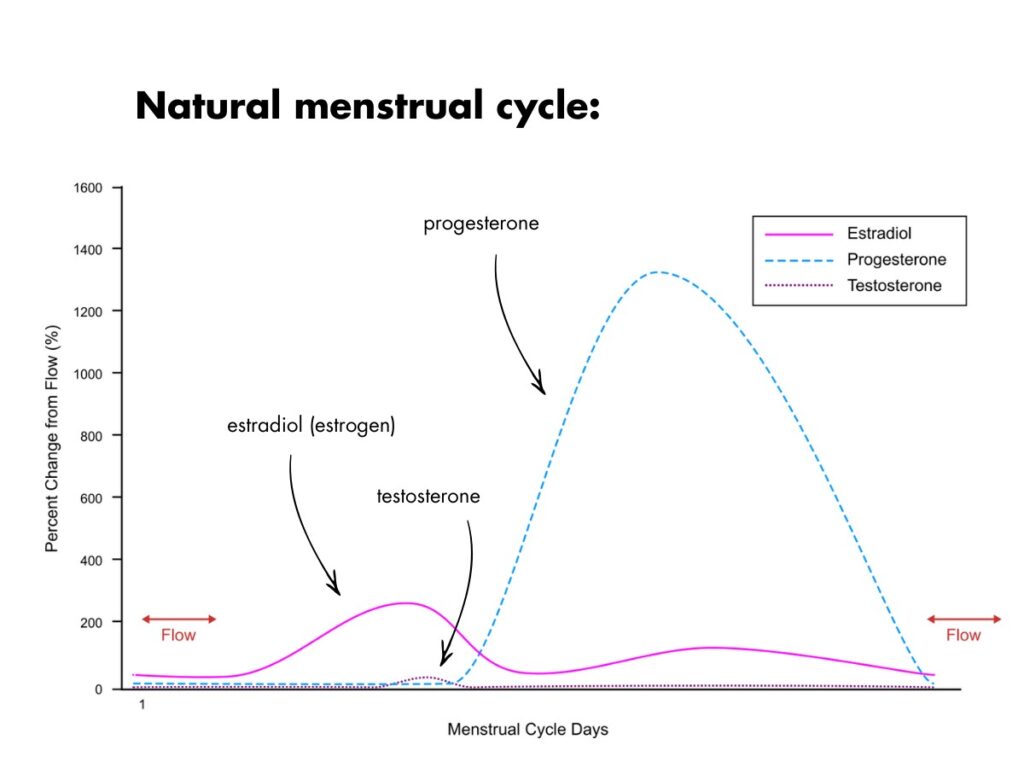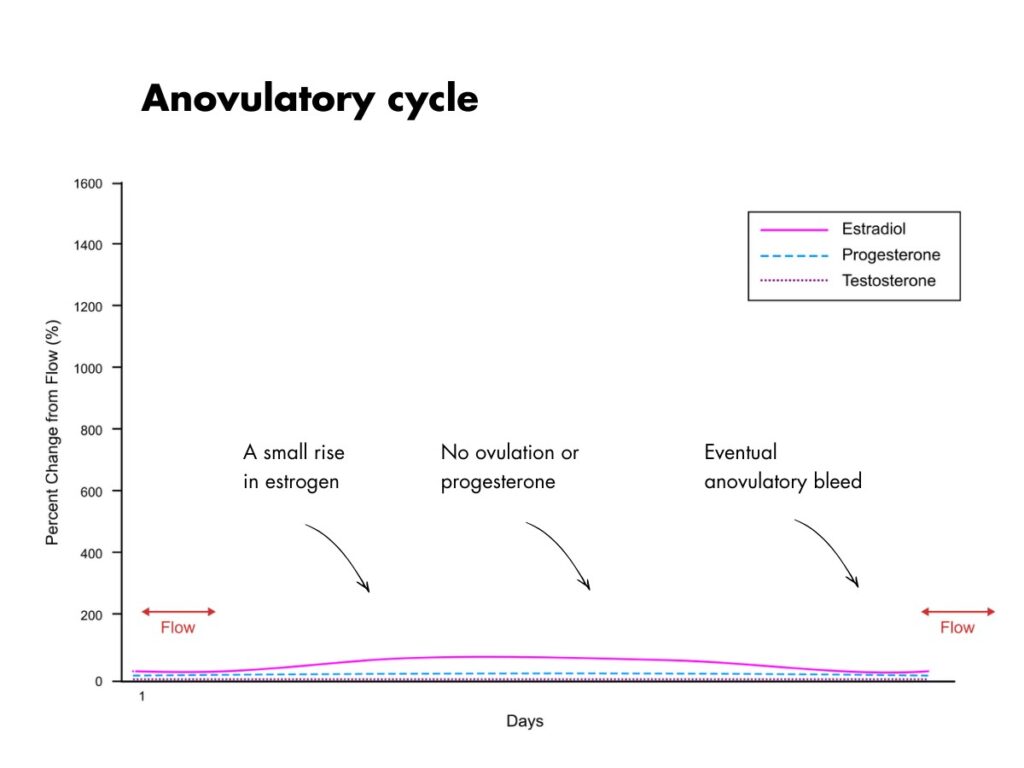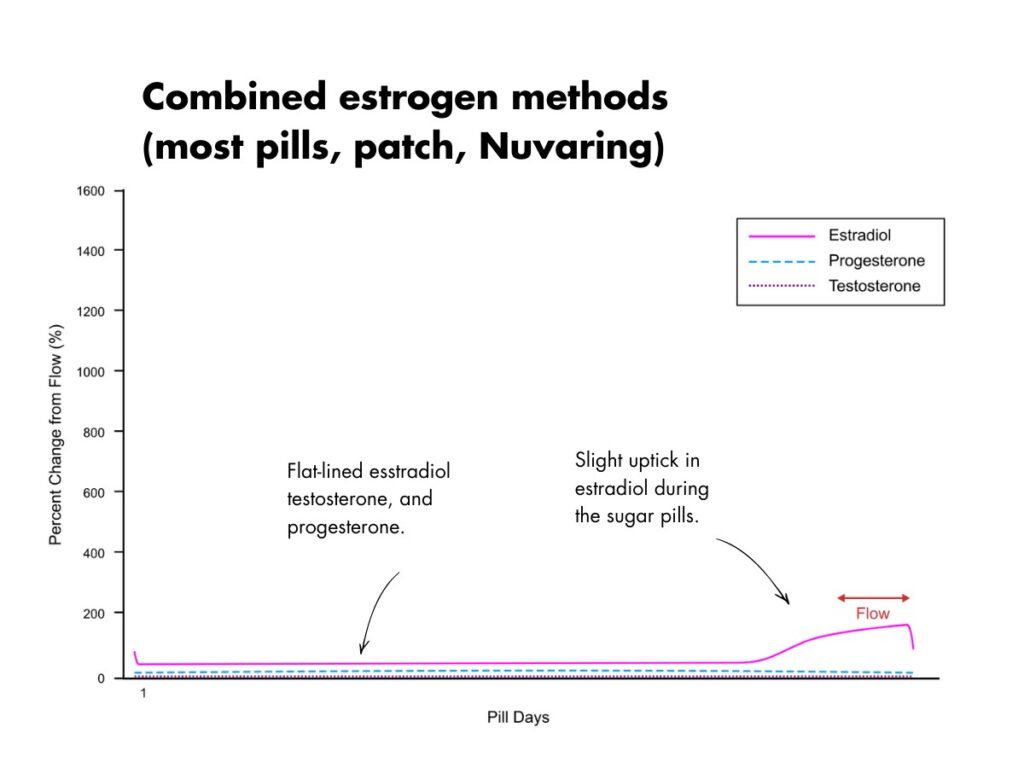 A menstrual cycle is, by definition, an ovulatory cycle in which ovulation is the main event and progesterone is made. Any other kind of bleed is either an anovulatory bleed or a pill bleed—neither of which is a real menstrual cycle.
A menstrual cycle is, by definition, an ovulatory cycle in which ovulation is the main event and progesterone is made. Any other kind of bleed is either an anovulatory bleed or a pill bleed—neither of which is a real menstrual cycle.
Furthermore, an ovulatory cycle is the only way to make progesterone, which is important for general health and not just for making a baby.
An ovulatory menstrual cycle has a follicular phase and a luteal phase
The follicular phase is the pre-ovulatory phase when estradiol is made. The luteal phase is the post-ovulatory phase when progesterone is made. It looks like this.

The follicular phase ranges from seven to 21 days (or up to 32 days for teenagers). It’s the variable part of the menstrual cycle.
In contrast, a healthy luteal phase should be in the range of ten to sixteen days. Shorter luteal phases are common but not healthy.
Summing the seven to 21 days of the follicular phase with the fourteen days of a healthy luteal phase, a healthy menstrual cycle should be between 21 to 35 days (or up to 45 days for teenagers).
💡Tip: To determine the length of your menstrual cycle, start counting from your first day of proper flow. That’s “day 1.” Any days of light spotting before the proper flow should be counted as the final days of the previous cycle.
An anovulatory cycle has no luteal phase or progesterone
An anovulatory cycle only has a long follicular phase and estrogen, followed by an eventual breakthrough bleed. It looks like this.

💡Tip: Progesterone is the “period-lightening” hormone, so the bleeds associated with anovulatory cycles can be heavier or go on for too long.
Other names for anovulatory cycles include:
- hormone imbalance
- estrogen and progesterone imbalance
- dysfunctional uterine bleeding
- ovulatory dysfunction
- unopposed estrogen
- estrogen dominance (a term I generally don’t use).
Untreated, anovulatory cycles can eventually lead to endometrial thickening, endometrial hyperplasia, or uterine polyps.
Causes of anovulatory cycles
It’s normal to have the occasional anovulatory cycle. If anovulatory cycles are frequent or constant, possible causes include:
- puberty
- PCOS
- high prolactin
- hypothalamic amenorrhea or undereating
- recovering from hormonal birth control
- perimenopause
💡Tip: The bleeds on progestin-only birth control are anovulatory.
Signs of an anovulatory cycle
How do you know if a cycle is anovulatory?
A cycle shorter than 21 days
Remember, counting from “day 1” to “day 1,” a healthy menstrual cycle is anywhere from 21 to 35 days (45 days if you’re a teenager). A cycle shorter than 21 days is almost always anovulatory.
A cycle longer than 45 days
A cycle longer than 35 days or (45 days for teenagers) is either 1) a cycle with a very long follicular phase or 2) an anovulatory cycle. A luteal phase longer than 16 days is not possible, except with pregnancy and the rare situation of a corpus luteum cyst.
A bleed that lasts more than seven days
A healthy menstrual bleed should last two to seven days, with no more than 80 mL of menstrual fluid lost over all the days of the bleed. Bleeding for longer than seven days can be a sign of an anovulatory cycle. The flow with an anovulatory bleed can be light, normal, or heavy.
A cycle with no sustained temperature rise
Progesterone increases basal body temperature rise by half a degree, so a sustained temperature rise for ten to fourteen days is solid evidence that ovulation occurred. Conversely, a lack of temperature rise confirms that ovulation did not occur.
💡Tip: You can also confirm ovulation with a properly timed serum test for progesterone. Read The right way to test progesterone.
How to treat anovulatory cycles
If you’re not ovulating, the solution is to figure out “why not” and treat that.
- If the underlying problem is PCOS, identify your PCOS type and treat that.
- If the underlying problem is undereating, eat more food and carbohydrates for at least six months.
- If the underlying problem is high prolactin, treat that.
I discuss other treatments in my books.
Pill bleeds are not periods
Finally, pill withdrawal bleeds are not menstrual cycles. On the pill, there’s no ovulation or even attempt at ovulation, so there’s no estradiol or progesterone. Hormone look like this:

Case in point: if you were to test serum levels of estradiol and progesterone while on the pill, there would be almost none—basically, menopausal levels of hormones.
Ask me in the comments.
